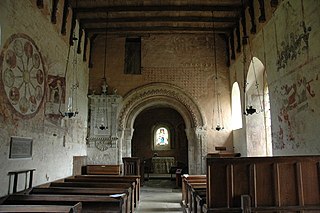The mention of English medieval wall paintings probably makes most people think of those which once ornamented churvhes either with religious scenes or patterned decoration. Today all we usually have are fragments, the result of the respective zeal of sixteenth century reformers and nineteenth century restorers. Where they do survive they are almost always faded and damaged.
Less well known, are much less common are secular buildings with wall paintings, be they religious or literary in their inspiration. Of these the best known are those at Longthorpe Tower just west of Peterborough. This thirteenth century crenellated manor house received a new tower early in the fourteenth century and about 1330 it was decorated with a series of wall paintings. Longthorpe, now situated slightly inconcrously on a suburban residential road, is well worth a visit. There is an introduction to it at Longthorpe Tower and an illustrated post from the British Library Medieval Manuscripts blog discusses the paintings in an illustrated post at Saints, kings and a bonnacon at Longthorpe Tower
Recently I have come across three articles which discuss both sacred and secular wall paintings, and indeed the link between the two themes - they are not exclusive.
The first from Apollo begins with one of the most significant cycles to survive in a church, that at Kempley in the Forest of Dean. I regret to say I have not yet managed to visit the church on my thourneys around the country.
Situated mid way between Gloucester and Hereford it is a small and remote church. Nonetheless it contains in the chancel the most important surviving cycle of paintings from about 1130 in north western Europe. The majestic scheme covers the walls and ceiling, with figures and patterning. I wonder to what extent it is connected to the Hereford artistic tradition that flourished in and around the cathedral close and across the diocese. with a great sculptural tradition and rich intellectual interests. Other wall paintings survive in the nave.
The nave of St Mary’s Church Kempley
Image: Wikipedia
There is an introduction to the church at Kempley and a fuller illustrated account from English Heritage who now manage the church at History of St Mary’s Church, Kempley
Kempley Church
Image: Wikipedia
Incidentally whilst thinking about painting walls the exterior of the church is rendered and painted a delicate shade of pink. This colourisation is often associated with East Anglia - “ Suffolk Pink” - but we know it was used to decorate the exterior of St Wilfrid’s church at Hexham in the seventh century. Before ashlar masonry became usual or in areas where it was not available rough masonry was apparently often rendered and white or colour washed. to make the building damp proof and to enhance its appearance.
The Apollo article then moved on to talk about the surviving late medieval religious paintings in the chapel of Eton College and the recently discovered painting of a Master presiding over teaching from the Head Master’s Chambers, dated to about 1520.
The Apollo article can be seen at England’s historic wall paintings
Slightly later in date is an important piece discovered in the former Rectory at Milverton in Somerset. This was the country retreat of the Archdeacon of Taunton, and prior to 1533 that was one Dr Thomas Cranmer. In recent years an enthroned painting of King Henry VIII from the 1530s - perhaps 1536, so after Cranmer’s time there - was revealed in the hall of the building. In concept it is similar to the image of King Richard II in Westminster Abbey. Presumably it fulfilled the same purpose as having a panel or canvas painting of the reigning monarch to express the Archdeacon’s loyalty.
There are reports about the discovery on the BBC News website at Mural of King Henry VIII uncovered in Somerset, from the Mail Online with a series of illustrations at The King's Head: Couple uncover 500-year-old painting of Henry VIII while renovating their home and there is another picture which shows the wider context from Country Life at Historic former rectory with a sixteenth century mural of Henry VIII inside
A slightly later scheme, dated to the late sixteenth or early seventeenth century.m, is featured in the third article This draws attention to the danger that home improvements in historic properties may unwittingly damage concealed survivals like the one featured. This series of paintings was recently uncovered in a house near Wellington in Herefordshire.
The article from the Guardian can be seen, together with illustrations at Makeover craze threatens last surviving treasures hidden beneath the wallpaper
Domestic paintings of this type survive here in Oxford and nearby in Abingdon. I have also
seen in a hotel in Tewkesbury remains of a decorative scheme. I recall how in my hometown of Pontefract during demotion work (alas) in the later 1960s, hidden behind Victorian canvas and paper, the remains of a handsome room of about 1600 were revealed with, above the wainscoting, a frieze painted with fruit and flowers.




No comments:
Post a Comment